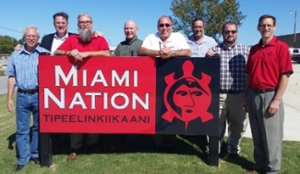IT, CEC, and Research Visit Miami Tribe

This fall a new chapter was opened in the ongoing story of the relationship between the Miami Tribe of Oklahoma and Miami University. What has become an enduring, mutually beneficial connection began in 1972 when then President Phillip Shriver and Chief Forest Olds met in Oxford. The connection has been fostered by Miami presidents and chiefs over the years.
In the 1990s education emerged as a new and powerful theme in this special collaboration with the development of the Miami Indian Heritage Award, which encouraged tribal youth to consider Miami for their post-secondary education. In 2001 the Myaamia Project was founded, succeeded by the Myaamia Center in 2013. Under the leadership of MacArthur Fellow Daryl Baldwin, the Center’s mission is to advance the research needs of the Miami Tribe of Oklahoma with a focus on the myaamia language, culture, and history. As with most research today, the Center uses information technology to support its mission, but the software and hardware they use has mostly grown organically.
 Technology projects have been underway through the Myaamia Center for several years under the direction of Dr. Doug Troy who also serves as a faculty affiliate of the Center. Recognizing the importance of technology in the projects developed by the Myaamia Center, Center staff and affiliates reached out to IT Services to initiate a series of discussions related to current challenges the Center was facing. The Center’s IT staff shared the specific ways they were using technology now, and how they envisioned technology enabling future research and development activities. IT Services staff members listened and learned: brainstorming how current services could support the Center’s needs.
Technology projects have been underway through the Myaamia Center for several years under the direction of Dr. Doug Troy who also serves as a faculty affiliate of the Center. Recognizing the importance of technology in the projects developed by the Myaamia Center, Center staff and affiliates reached out to IT Services to initiate a series of discussions related to current challenges the Center was facing. The Center’s IT staff shared the specific ways they were using technology now, and how they envisioned technology enabling future research and development activities. IT Services staff members listened and learned: brainstorming how current services could support the Center’s needs.
A unique feature of the Myaamia Center is that it operates both on the Oxford campus and directly with the Miami Tribe’s Cultural Resources Office at the Miami tribal headquarters in Oklahoma. The Center is responsible for carrying out research that provides critical content for educational programs, but also works with tribal leaders to develop community-based educational programs and initiatives related to myaamia language, culture, and history. To investigate the opportunities and challenges that this dual site structure provide, the IT and Myaamia Center staff members, along with faculty affiliate Troy and Jim Oris, dean of the Graduate School and associate provost for Research, visited Oklahoma near the end of September 2016. The group used a workshop format to identify the immediate needs and foundational activities that IT Services could support.
The IT Services staff came back with a list of “quick wins” – small changes that could make the Center’s technology environment stronger and more responsive to their needs. The group has been ticking things off this list since their return from the Oklahoma visit in September.
One basic need was for a place to store all of the information the Center has created and manages. The large and growing myaamia language digital archive and dictionary and an online museum exhibition, myaamiaaki iši meehtohseeniwicki, curated by the Miami Art Museum, are only two examples of the information that is moving to servers in the IT Services data center. A total of nine terabytes of storage is now dedicated to Center’s active and archived files.
Also on the “quick win” list identified at the Oklahoma workshop is a review of the hosting strategy for the Center’s websites, upgrading network service to the Bonham House offices of the Center, and performing a network security audit. Those items will be the next that the group tackles.
“The Myaamia Center is faced with the challenge of keeping pace with quickly evolving technologies while at the same time using these technologies to meet the language and cultural educational needs of the community, explained Baldwin. “The excellent support we have received from the IT staff here at Miami has been critical for developing our internal intranet capacity, which allows the Myaamia Center to meet its growing needs.”

